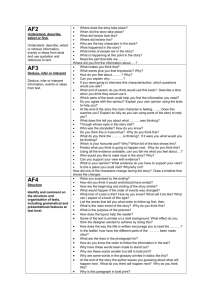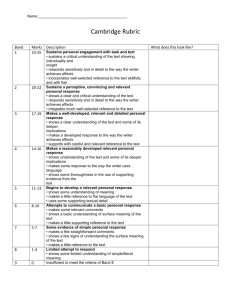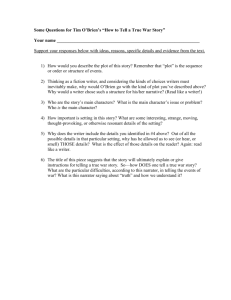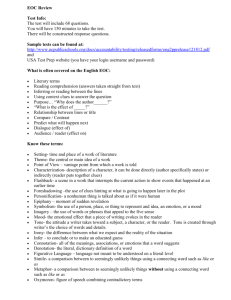student_friendly_app_readingb (3)
advertisement
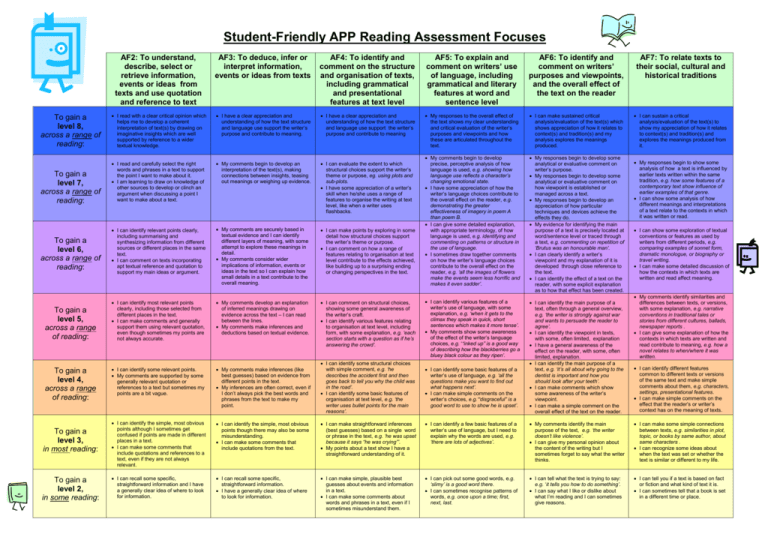
Student-Friendly APP Reading Assessment Focuses AF2: To understand, describe, select or retrieve information, events or ideas from texts and use quotation and reference to text AF3: To deduce, infer or interpret information, events or ideas from texts AF4: To identify and comment on the structure and organisation of texts, including grammatical and presentational features at text level AF5: To explain and comment on writers’ use of language, including grammatical and literary features at word and sentence level AF6: To identify and comment on writers’ purposes and viewpoints, and the overall effect of the text on the reader AF7: To relate texts to their social, cultural and historical traditions To gain a level 8, across a range of reading: I read with a clear critical opinion which helps me to develop a coherent interpretation of text(s) by drawing on imaginative insights which are well supported by reference to a wider textual knowledge. I have a clear appreciation and understanding of how the text structure and language use support the writer’s purpose and contribute to meaning. I have a clear appreciation and understanding of how the text structure and language use support the writer’s purpose and contribute to meaning My responses to the overall effect of the text shows my clear understanding and critical evaluation of the writer’s purposes and viewpoints and how these are articulated throughout the text. I can make sustained critical analysis/evaluation of the text(s) which shows appreciation of how it relates to context(s) and tradition(s) and my analysis explores the meanings produced. I can sustain a critical analysis/evaluation of the text(s) to show my appreciation of how it relates to context(s) and tradition(s) and explores the meanings produced from it. To gain a level 7, across a range of reading: I read and carefully select the right words and phrases in a text to support the point I want to make about it. I am learning to draw on knowledge of other sources to develop or clinch an argument when discussing a point I want to make about a text. My comments begin to develop an interpretation of the text(s), making connections between insights, teasing out meanings or weighing up evidence. I can evaluate the extent to which structural choices support the writer’s theme or purpose, eg. using plots and sub-plots. I have some appreciation of a writer’s skill when he/she uses a range of features to organise the writing at text level, like when a writer uses flashbacks. I can identify relevant points clearly, including summarising and synthesizing information from different sources or different places in the same text. I can comment on texts incorporating apt textual reference and quotation to support my main ideas or argument. My comments are securely based in textual evidence and I can identify different layers of meaning, with some attempt to explore these meanings in detail. My comments consider wider implications of information, events or ideas in the text so I can explain how small details in a text contribute to the overall meaning. I can make points by exploring in some detail how structural choices support the writer’s theme or purpose. I can comment on how a range of features relating to organisation at text level contribute to the effects achieved, like building up to a surprising ending or changing perspectives in the text. My comments begin to develop precise, perceptive analysis of how language is used, e.g. showing how language use reflects a character’s changing emotional state. I have some appreciation of how the writer’s language choices contribute to the overall effect on the reader, e.g. demonstrating the greater effectiveness of imagery in poem A than poem B. I can give some detailed explanation, with appropriate terminology, of how language is used, e.g. identifying and commenting on patterns or structure in the use of language. I sometimes draw together comments on how the writer’s language choices contribute to the overall effect on the reader, e.g. ‘all the images of flowers make the events seem less horrific and makes it even sadder’. My responses begin to develop some analytical or evaluative comment on writer’s purpose. My responses begin to develop some analytical or evaluative comment on how viewpoint is established or managed across a text. My responses begin to develop an appreciation of how particular techniques and devices achieve the effects they do. My evidence for identifying the main purpose of a text is precisely located at word/sentence level or traced through a text, e.g. commenting on repetition of ‘Brutus was an honourable man’. I can clearly identify a writer’s viewpoint and my explanation of it is developed through close reference to the text. I can identify the effect of a text on the reader, with some explicit explanation as to how that effect has been created. I can identify most relevant points clearly, including those selected from different places in the text. I can make comments and generally support them using relevant quotation, even though sometimes my points are not always accurate. My comments develop an explanation of inferred meanings drawing on evidence across the text – I can read between the lines. My comments make inferences and deductions based on textual evidence. I can comment on structural choices, showing some general awareness of the writer’s craft. I can identify various features relating to organisation at text level, including form, with some explanation, e.g. ‘each section starts with a question as if he’s answering the crowd’. I can identify various features of a writer’s use of language, with some explanation, e.g. ‘when it gets to the climax they speak in quick, short sentences which makes it more tense’. My comments show some awareness of the effect of the writer’s language choices, e.g. ‘“inked up” is a good way of describing how the blackberries go a bluey black colour as they ripen’. I can identify some relevant points. My comments are supported by some generally relevant quotation or references to a text but sometimes my points are a bit vague. My comments make inferences (like best guesses) based on evidence from different points in the text. My inferences are often correct, even if I don’t always pick the best words and phrases from the text to make my point. I can identify the main purpose of a text, often through a general overview, e.g. ‘the writer is strongly against war and wants to persuade the reader to agree’. I can identify the viewpoint in texts, with some, often limited, explanation I have a general awareness of the effect on the reader, with some, often limited, explanation. I can identify the main purpose of a text, e.g. ‘it’s all about why going to the dentist is important and how you should look after your teeth’. I can make comments which show some awareness of the writer’s viewpoint. I can make a simple comment on the overall effect of the text on the reader. I can identify the simple, most obvious points although I sometimes get confused if points are made in different places in a text. I can make some comments that include quotations and references to a text, even if they are not always relevant. I can identify the simple, most obvious points though there may also be some misunderstanding. I can make some comments that include quotations from the text. I can make straightforward inferences (best guesses) based on a single word or phrase in the text, e.g. ‘he was upset because it says “he was crying”’. My points about a text show I have a straightforward understanding of it. I can identify a few basic features of a writer’s use of language, but I need to explain why the words are used, e.g. ‘there are lots of adjectives’. My comments identify the main purpose of the text, e.g. ‘the writer doesn’t like violence’. I can give my personal opinion about the content of the writing but I sometimes forget to say what the writer thinks. I can make some simple connections between texts, e.g. similarities in plot, topic, or books by same author, about same characters . I can recognize some ideas about when the text was set or whether the text is similar or different to my life. I can recall some specific, straightforward information and I have a generally clear idea of where to look for information. I can recall some specific, straightforward information. I have a generally clear idea of where to look for information. I can make simple, plausible best guesses about events and information in a text. I can make some comments about words and phrases in a text, even if I sometimes misunderstand them. I can pick out some good words, e.g. ‘slimy’ is a good word there. I can sometimes recognise patterns of words, e.g. once upon a time; first, next, last. I can tell what the text is trying to say: e.g. ‘it tells you how to do something’. I can say what I like or dislike about what I’m reading and I can sometimes give reasons. I can tell you if a text is based on fact or fiction and what kind of text it is. I can sometimes tell that a book is set in a different time or place. To gain a level 6, across a range of reading: To gain a level 5, across a range of reading: To gain a level 4, across a range of reading: To gain a level 3, in most reading: To gain a level 2, in some reading: I can identify some structural choices with simple comment, e.g. ‘he describes the accident first and then goes back to tell you why the child was in the road’. I can identify some basic features of organisation at text level, e.g. ‘the writer uses bullet points for the main reasons’. I can identify some basic features of a writer’s use of language, e.g. ‘all the questions make you want to find out what happens next’. I can make simple comments on the writer’s choices, e.g.‘“disgraceful” is a good word to use to show he is upset’. My responses begin to show some analysis of how a text is influenced by earlier texts written within the same tradition, e.g. how some features of a contemporary text show influence of earlier examples of that genre. I can show some analysis of how different meanings and interpretations of a text relate to the contexts in which it was written or read. I can show some exploration of textual conventions or features as used by writers from different periods, e.g. comparing examples of sonnet form, dramatic monologue, or biography or travel writing. I can make some detailed discussion of how the contexts in which texts are written and read affect meaning. My comments identify similarities and differences between texts, or versions, with some explanation, e.g. narrative conventions in traditional tales or stories from different cultures, ballads, newspaper reports . I can give some explanation of how the contexts in which texts are written and read contribute to meaning, e.g. how a novel relates to when/where it was written. I can identify different features common to different texts or versions of the same text and make simple comments about them, e.g. characters, settings, presentational features. I can make simple comments on the effect that the reader’s or writer’s context has on the meaning of texts.
